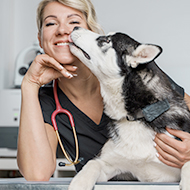Your practice, through your clients' eyes
Helen offered some practical points on making sure the client's arrival at the practice is as stress-free as possible.
Helen Tottey explains customer experience at BVNA Congress
A client's experience in practice is 'multi-sensory' and veterinary nurses should view their practice through the clients' eyes, said Helen Tottey during a lecture at BVNA Congress.
Customer experience was broken down into five sections - the first phone call, ease of getting to the practice, greeting/waiting room, the consultation itself and what happens after the appointment.
Delegates were encouraged to be mindful of phone conversations; to be friendly, engaging and to book the caller in for an appointment.
The client may refuse the appointment if they want to get prices from other practices. But, if they have a really useful conversation with you, while another practice simply gives them a price, they are highly likely to call you back.
Potential clients never phone and ask how you can help with the lifetime care of their pet, Helen pointed out. They will start by asking how much your vaccinations cost, or what they should do about a suspected flea infestation. It is vital the correct information is given by reception staff.
Helen also offered some practical points on making sure the client's arrival at the practice is as stress-free as possible. For example, does your post code take a Sat Nav directly to your practice, is there an easy-access car park and does the individual pet suffer from anxiety?
Providing recommendations about travelling with pets and keeping them calm are a useful addition to practice websites.
Once the client has made it into the practice, a friendly greeting from reception staff and the smell/appearance of the waiting room are key. This is the first impression the client will receive. Are the posters in your waiting room topical and useful? Are they selling your services?
Language was also highlighted as an essential part of customer care. Call the pet by their name and refer to them as 'he' or 'she' - not 'it'. In addition, if you take a patient 'out the back', using this phrasing can conjure up unpleasant associations in the client's mind, so be sure to explain what will actually happen to their pet.
With rising emphasis on customer service, individual care is becoming more and more important. So, if you are hospitalising a patient, ask the client what their pet's favourite food and treats are and tell them they will get a comfy bed and cuddles from the practice nurses. They may well have a bleak impression of what kennels will be like.
All in all, feelings are key to customer care - when clients refer to the service they receive from practices, they tend to talk about how it made them feel, not what was done.







 Birmingham Dogs Home has issued an urgent winter appeal as it faces more challenges over the Christmas period.
Birmingham Dogs Home has issued an urgent winter appeal as it faces more challenges over the Christmas period.
